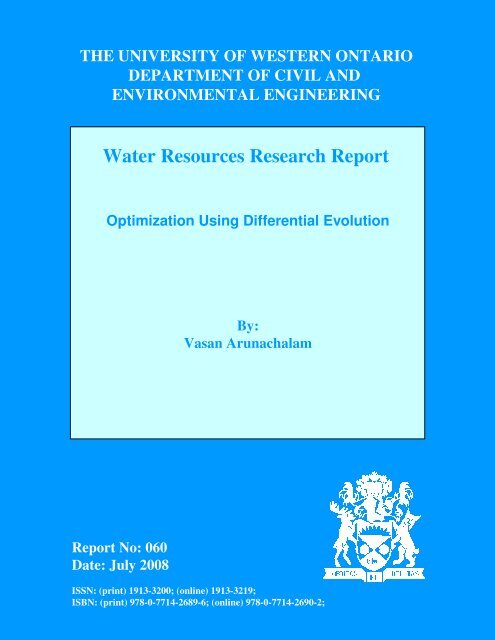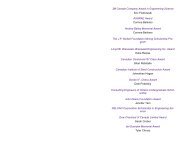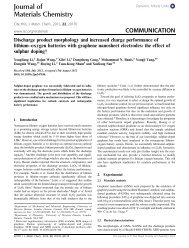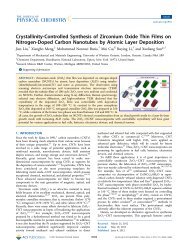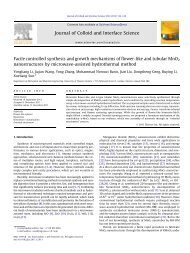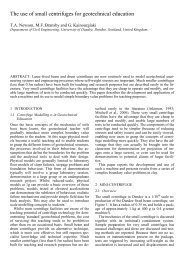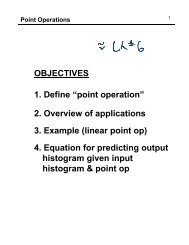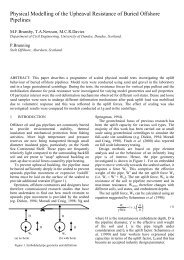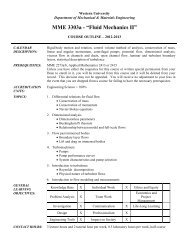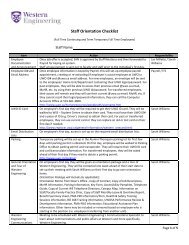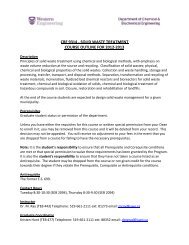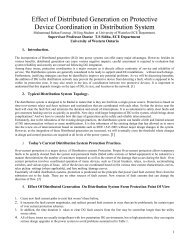Water Resources Research Report - Western Engineering ...
Water Resources Research Report - Western Engineering ...
Water Resources Research Report - Western Engineering ...
You also want an ePaper? Increase the reach of your titles
YUMPU automatically turns print PDFs into web optimized ePapers that Google loves.
THE UNIVERSITY OF WESTERN ONTARIO<br />
DEPARTMENT OF CIVIL AND<br />
ENVIRONMENTAL ENGINEERING<br />
<strong>Water</strong> <strong>Resources</strong> <strong>Research</strong> <strong>Report</strong><br />
Optimization Using Differential Evolution<br />
<strong>Report</strong> No: 060<br />
Date: July 2008<br />
By:<br />
Vasan Arunachalam<br />
ISSN: (print) 1913-3200; (online) 1913-3219;<br />
ISBN: (print) 978-0-7714-2689-6; (online) 978-0-7714-2690-2;
OPTIMIZATION USING DIFFERENTIAL EVOLUTION<br />
By<br />
VASAN ARUNACHALAM<br />
Facility for Intelligent Decision Support<br />
Department of Civil and Environmental <strong>Engineering</strong><br />
The University Of <strong>Western</strong> Ontario, London, Ontario, Canada<br />
JULY 2008
ABSTRACT<br />
The book explains in detail the working of Differential Evolution optimization algorithm.<br />
It also provides documentation for the use of Differential Evolution computer program to<br />
solve user-defined optimization problems. The computer program is written in C<br />
language for Windows environment. The book also demonstrates how to modify the<br />
program using an example optimization problem.<br />
This source code is distributed for academic purposes only. It has no warranty implied or<br />
given, and the author assumes no liability for damage resulting from its use or misuse.<br />
The author can be contacted for any comments by email at<br />
vasan.arunachalam@gmail.com.<br />
i
TABLE OF CONTENTS<br />
ABSTRACT……………………………………………………………………... i<br />
TABLE OF CONTENTS………………………………………………………... ii<br />
1 INTRODUCTION……………………………………………………………… 1<br />
2 DIFFERENTIAL EVOLUTION……………………………………………… 3<br />
WORKING OF THE DE ALGORITHM……………………………………….. 3<br />
AN ILLUSTRATIVE EXAMPLE………..…………………………………….. 7<br />
3 HOW TO RUN THE DE PROGRAM?............................................................. 10<br />
4 CONCLUSION…………………………………………………………………. 19<br />
REFERENCES…………………………………………………………………. 20<br />
APPENDIX A - SOURCE CODE OF THE DE ALGORITHM IN C……… 21<br />
APPENDIX B - PREVIOUS REPORTS IN THE SERIES 35<br />
ii
CHAPTER<br />
1<br />
INTRODUCTION<br />
Optimization is a procedure through which the best possible values of decision variables<br />
are obtained under the given set of constraints and in accordance to a selected<br />
optimization objective function. The most common optimization procedure applies to a<br />
design that will minimize the total cost or maximize the possible reliability or any other<br />
specific objective. Fields of science and engineering, business decision-making and<br />
industry are all rich in problems that require the implementation of optimization<br />
approach. Since, most real world optimization problems seem to be both fundamentally<br />
and practically hard, research into better algorithms remains valuable and continues, so<br />
that, one can guarantee to find the best solution using an efficient optimization algorithm.<br />
Nowadays, there exist a lot of optimization algorithms that work using gradient-based<br />
and heuristic-based search techniques in deterministic and stochastic contexts. In order to<br />
widen the applicability of the optimization approach to various problem domains, natural<br />
and physical principles are mimicked to develop robust optimization algorithms.<br />
Evolutionary algorithms, simulated annealing, ant colony optimization, memetic<br />
algorithms, particle swarm optimization are few examples of such algorithms.<br />
Over the last decade, evolutionary algorithms have been extensively used in various<br />
problem domains and succeeded in effectively finding the near optimal solutions. The<br />
present book provides a detailed description of one such evolutionary algorithm, named,<br />
Differential Evolution (DE). Since its inception in 1995, DE has earned a reputation of a<br />
very effective global optimizer (Storn and Price, 1995). Chapter 1 begins with an<br />
introduction to the optimization and Chapter 2 introduces the detailed working of DE<br />
1
algorithm with an illustrative example. Chapter 3 provides the instructions for using the<br />
DE computer program developed for Windows environment that accompanies this book<br />
on CD-ROM. Chapter 4 concludes with few practical suggestions for the users of the DE<br />
computer program. An Appendix to the text contains description of the source code of<br />
DE software developed in C programming language.<br />
2
WORKING OF THE DE ALGORITHM<br />
CHAPTER<br />
2<br />
DIFFERENTIAL EVOLUTION<br />
Differential Evolution (DE) algorithm is a branch of evolutionary programming<br />
developed by Rainer Storn and Kenneth Price (Price and Storn, 1997) for optimization<br />
problems over continuous domains. In DE, each variable’s value is represented by a real<br />
number. The advantages of DE are its simple structure, ease of use, speed and robustness.<br />
DE is one of the best genetic type algorithms for solving problems with the real valued<br />
variables. Differential Evolution is a design tool of great utility that is immediately<br />
accessible for practical applications. DE has been used in several science and engineering<br />
applications to discover effective solutions to nearly intractable problems without<br />
appealing to expert knowledge or complex design algorithms. If a system is amenable to<br />
being rationally evaluated, DE can provide the means for extracting the best possible<br />
performance from it. Differential Evolution uses mutation as a search mechanism and<br />
selection to direct the search toward the prospective regions in the feasible region.<br />
Genetic Algorithms generate a sequence of populations by using selection mechanisms.<br />
Genetic Algorithms use crossover and mutation as search mechanisms. The principal<br />
difference between Genetic Algorithms and Differential Evolution is that Genetic<br />
Algorithms rely on crossover, a mechanism of probabilistic and useful exchange of<br />
information among solutions to locate better solutions, while evolutionary strategies use<br />
mutation as the primary search mechanism.<br />
DE is a population based search technique which utilizes NP variables as population of D<br />
dimensional parameter vectors for each generation. The initial population is chosen<br />
3
andomly if no information is available about the problem. In the case of the available<br />
preliminary solution, the initial population is often generated by adding normally<br />
distributed random deviations to the preliminary solution. The basic idea behind DE is a<br />
new scheme for generating trial parameter vectors. DE generates new parameter vectors<br />
by adding the weighted difference vector between two population members to a third<br />
member. If the resulting vector yields a lower objective function value than a<br />
predetermined population member, the newly generated vector replaces the vector with<br />
which it was compared. In addition, the best parameter vector is evaluated for every<br />
generation in order to keep track of the progress that is made during the optimization<br />
process. Extracting the distance and the direction information from the population to<br />
generate random deviations result in an adaptive scheme with excellent convergence<br />
properties (Price et al., 2005).<br />
DE maintains two arrays, each of which holds a population size NP and D dimensional,<br />
real-valued vectors. The primary array holds the current vector population, while the<br />
secondary array accumulates vectors that are selected for the next generation. In each<br />
generation, NP competitions are held to determine the composition of the next<br />
generation.<br />
Every pair of vectors ( a , b ) X X defines a vector differential: ) ( a b X X − . When X a and<br />
X b are chosen randomly, their weighted differential is used to perturb another randomly<br />
chosen vector X c . This process can be mathematically expressed as:<br />
′<br />
X c = X c + F(<br />
X a − X b )<br />
The weighting, or scaling, factor F is a user supplied constant in the optimal range<br />
between 0.5 and 1.0 (DE, 2008). In every generation, each primary array vector X i is<br />
targeted for crossover with a vector like<br />
(1)<br />
′<br />
X c to produce a trial vector X t . Thus, the trial<br />
vector is the child of two parents, a noisy random vector and the target vector against<br />
which it must compete. Uniform crossover (that can take child vector parameters from<br />
4
one parent more often than it does from others) is used with a crossover constant (CR), in<br />
the optimal range of 0.5 to 1.0 (DE, 2008) which actually represents the probability that<br />
the child vector inherits the parameter values from the noisy random vector. When CR =<br />
1, for example, every trial vector parameter is certain to come from ′<br />
X c . On the other<br />
hand, if CR = 0, all but one trial vector parameter comes from the target vector. To ensure<br />
that X t differs from X i by at least one parameter, the final trial vector parameter always<br />
comes from the noisy random vector even when CR = 0. Then the objective function<br />
corresponding to the trial vector is compared with that of the target vector, and the vector<br />
that has the lower objective function value (for minimization) of the two would survive<br />
for the next generation. This process is continued until the termination criterion of a<br />
preset maximum number of generations (MAXGEN) is met, and difference in objective<br />
function values between two consecutive generations reaches a small value. Figure 1<br />
shows the working of the DE algorithm.<br />
Fig. 1. Working of Differential Evolution Algorithm<br />
5
Price & Storn (1997) gave the working principle of DE with single strategy. Later on,<br />
they suggested ten different strategies for DE. Different strategies can be adopted in the<br />
DE algorithm depending upon the type of problem to which DE is applied. The strategies<br />
can vary based on the vector to be perturbed, number of difference vectors considered for<br />
perturbation, and finally the type of crossover used. The following are the ten different<br />
working strategies:<br />
1. DE/best/1/exp<br />
2. DE/rand/1/exp<br />
3. DE/rand-to-best/1/exp<br />
4. DE/best/2/exp<br />
5. DE/rand/2/exp<br />
6. DE/best/1/bin<br />
7. DE/rand/1/bin<br />
8. DE/rand-to-best/1/bin<br />
9. DE/best/2/bin<br />
10. DE/rand/2/bin<br />
The general convention used above is DE/x/y/z. DE stands for Differential Evolution, x<br />
represents a string denoting the vector to be perturbed, y is the number of difference<br />
vectors considered for perturbation of x, and z stands for the type of crossover being used<br />
(exp: exponential; bin: binomial). Hence the perturbation can be either in the best vector<br />
of the previous generation or in any randomly chosen vector. Similarly for perturbation<br />
either single or two vector differences can be used. For perturbation with a single vector<br />
difference, out of the three distinct randomly chosen vectors, the weighted vector<br />
differential of any two vectors is added to the third one. Similarly for perturbation with<br />
two vector differences, five distinct vectors, other than the target vector are chosen<br />
randomly from the current population. Out of these, the weighted vector difference of<br />
each pair of any four vectors is added to the fifth one for perturbation. In exponential<br />
crossover, the crossover is performed on the D variables in one loop until it is within the<br />
CR bound. The first time a randomly picked number between 0 and 1 goes beyond the<br />
CR value, no crossover is performed and the remaining D variables are left intact. In<br />
6
inomial crossover, the crossover is performed on each of the D variables whenever a<br />
randomly picked number between 0 and 1 is within the CR value. So for high values of<br />
CR, the exponential and binomial crossover methods yield similar results.<br />
A strategy that works out to be the best for a given problem may not work well when<br />
applied to a different problem. Also, the strategy and the key parameters to be adopted<br />
for a problem are to be determined by trial and error. However, strategy-7<br />
(DE/rand/1/bin) appears to be the most successful and the most widely used strategy. In<br />
all, three factors control evolution under DE, the population size NP, the weight applied<br />
to the random differential F and the crossover constant CR. More details regarding DE<br />
are available in Price and Storn (1997), Onwubolu and Babu (2004) and Price and Storn<br />
(2005).<br />
AN ILLUSTRATIVE EXAMPLE<br />
A simple numerical example is presented to illustrate the DE algorithm. Let us consider<br />
the following objective function:<br />
Minimize f ( x)<br />
= x + x + x<br />
(2)<br />
1<br />
2<br />
3<br />
The initial population is generated (chosen randomly between the bounds of decision<br />
variables, in this case within 0 and 1, for the three decision variables. The population<br />
along with its respective objective function values is shown in Table 1. The first member<br />
of the population “Individual 1” is set as the target vector.<br />
In order to generate the noisy random vector, three individuals (Individual 2, Individual 4<br />
and Individual 6) from the population size are selected randomly (ignoring “Individual<br />
1”, since it is set as the target vector). The weighted difference between “Individual 2”<br />
and “Individual 4” is added to the third randomly chosen vector “Individual 6” to<br />
generate the noisy random vector. The weighting factor F is chosen as 0.80 and the<br />
weighted difference vector is obtained in Table 2 and the noisy random vector in Table 3.<br />
7
Individual<br />
1<br />
Table 1. An illustrative example<br />
Population Size NP = 6 (user defined), D = 3<br />
Individual<br />
2<br />
Individual<br />
3<br />
Individual<br />
4<br />
Individual<br />
5<br />
Individual<br />
6<br />
x 1 0.68 0.92 0.22 0.12 0.40 0.94<br />
x 2 0.89 0.92 0.14 0.09 0.81 0.63<br />
x 3 0.04 0.33 0.40 0.05 0.83 0.13<br />
f (x)<br />
1.61 2.17 0.76 0.26 2.04 1.70<br />
Table 2. Calculation of the weighted difference vector for the illustrative example<br />
Individual<br />
2<br />
Individual<br />
4<br />
Difference<br />
Vector<br />
Weighted<br />
Difference<br />
Vector<br />
x 1 0.92 0.12 = 0.80 = 0.64<br />
x 2 0.92 - 0.09 = 0.83<br />
× F<br />
(F = 0.80)<br />
= 0.66<br />
0.05 = 0.28<br />
= 0.22<br />
x 3 0.33<br />
Table 3. Calculation of the noisy random vector for the illustrative example<br />
Weighted<br />
Difference<br />
Vector<br />
Individual<br />
6<br />
Noisy<br />
Random<br />
Vector<br />
x 1 0.64 0.94 = 1.58<br />
x 0.66 + 0.63 = 1.29<br />
2<br />
x 3 0.22<br />
0.13 = 0.35<br />
The noisy random vector does a crossover with the target vector to generate the trial<br />
vector as shown in Table 4. This is carried out by (1) generating random numbers equal<br />
to the dimension of the problem (2) for each of the dimensions: if random number > CR;<br />
copy the value from the target vector, else copy the value from the noisy random vector<br />
into the trial vector. In this example, the crossover constant CR is chosen as 0.50.<br />
8
Table 4. Generation of the trial vector for the illustrative example<br />
Target<br />
Vector<br />
Noisy<br />
Random<br />
Vector<br />
Trial<br />
Vector<br />
x 1 0.68<br />
Crossover<br />
1.58 = 1.58<br />
x 2 0.89 (CR =<br />
0.50)<br />
1.29<br />
0.35<br />
= 0.89<br />
= 0.04<br />
x 3 0.04<br />
f (x)<br />
1.61 3.22 2.51<br />
The objective function of the trial vector is compared with that of the target vector and<br />
the vector with the lowest value of the two becomes “Individual 1” for the next<br />
generation. To evolve “Individual 2” for the next generation, the second member of the<br />
population is set as target vector and the above process is repeated. This process is<br />
repeated NP times till the new population set array is filled which completes one<br />
generation. Once the termination criterion is met, the algorithm ends.<br />
Table 5. New population for next generation for the illustrative example<br />
Individual<br />
1<br />
x 1 0.68<br />
x 2 0.89<br />
x 3 0.04<br />
f (x)<br />
1.61<br />
Individual<br />
2<br />
New Population for Next Generation<br />
Individual<br />
3<br />
Individual<br />
4<br />
Individual<br />
5<br />
Individual<br />
6<br />
9
CHAPTER<br />
3<br />
HOW TO RUN THE DE PROGRAM?<br />
Single objective Differential Evolution optimization algorithm has been programmed in<br />
C language using Microsoft Visual C++ 6.0 for Windows. This Chapter explains how to<br />
use the DE computer program for solving any optimization problem. The source code of<br />
the DE program is available in Appendix I. The CD enclosed along with this book<br />
contains a folder named “Program”. The folder contains the C program file “DE.c” which<br />
requires two input files, “Limits.txt” and “ParameterLimits.txt”. The program generates<br />
two output files, “<strong>Report</strong>DE.html” and “Convergence.txt”.<br />
In order to learn how to use the DE program, consider the following optimization<br />
problem:<br />
subject to<br />
( ) ( ) 2<br />
2<br />
2<br />
2<br />
x + x −11<br />
+ x + x 7<br />
Minimize f ( x)<br />
=<br />
−<br />
( x − 5)<br />
4x<br />
x , x<br />
1<br />
1<br />
1<br />
− x<br />
2<br />
2<br />
2<br />
≥ 0<br />
+ x<br />
2<br />
2<br />
− 20 ≤ 0<br />
1<br />
− 26 ≤ 0<br />
2<br />
The algorithm is designed to accept optimization problem with an objective of<br />
minimization type. If the objective of the problem is of maximization type, it should be<br />
modified accordingly to use in the program. Each decision variable is represented from<br />
x[0], x[1], x[2] and so on. Accordingly, the objective function for the example is written<br />
as follows:<br />
1<br />
(x[0]*x[0]+x[1]-11)*(x[0]*x[0]+x[1]-11)+(x[0]+x[1]*x[1]-7)*(x[0]+x[1]*x[1]-7)<br />
2<br />
10
To enter the constraints, the inequality constraints should be modified to the less or equal<br />
format, g( x)<br />
≤ 0.<br />
If the problem is an unconstrained optimization problem, the user need<br />
not enter anything in the space specified for the constraints coding. The constraints of the<br />
example are entered as follows:<br />
/* Constraint 1*/<br />
temp = (x[0]-5)*(x[0]-5) + x[1]*x[1] - 26;<br />
val[1] = max(temp,0);<br />
/* Constraint 2 */<br />
temp = 4*x[0] + x[1] -20;<br />
val[2] = max(temp,0);<br />
If the first constraint of the example is an equality constraint, the constraint should be<br />
entered as follows:<br />
/* Constraint 1 (Equality Condition) */<br />
val[1] = abs((x[0]-5)*(x[0]-5) + x[1]*x[1] – 26);<br />
where val[1] and val[2] represent the amount of violation for each constraint. These<br />
values are multiplied by a penalty co-efficient penal[1] and penal[2] (entered by the user<br />
of the program), which is then added to the objective function to continue the process of<br />
optimization. This process is often termed as penalty function approach. A simple<br />
additive penalty function approach is used in order to convert the constrained problem<br />
into unconstrained problem. Due to this conversion, the solution falling outside the<br />
feasible region is penalized and forced to fall into the feasible solution space after a few<br />
generations. However, the penalty function method has certain weaknesses that are fatal<br />
when the penalty parameters are large. Penalty functions tend to be ill conditioned near<br />
the boundary of the feasible domain and that may result in a local optimal solution or an<br />
11
infeasible solution. Careful selection of the penalty parameters is required for the proper<br />
convergence to a feasible optimal solution.<br />
The main C program has many user-defined functions. The user needs to enter objective<br />
function and constraints in the user-defined function evaluate( ). The program code is<br />
commented, so the user needs to follow the comments to enter the number of constraints,<br />
ncons (in this example, ncons = 2), objective function, constraints (if any) and the penalty<br />
coefficient for each constraint (if any), at the appropriate places. The “evaluate( )”<br />
function for the example problem is displayed below:<br />
double evaluate(double *x)<br />
{<br />
int ncons, i;<br />
double *val, *penal, temp;<br />
long double value=0;<br />
feval++;<br />
/* DO NOT CHANGE ANYTHING ABOVE */<br />
/* Enter the Number of Constraints to the variable ncons*/<br />
ncons = 2;<br />
/*------------------------------------------------------*/<br />
val = (double *)malloc(sizeof(double)*ncons);<br />
penal = (double *)malloc(sizeof(double)*ncons);<br />
penal[0]=1;<br />
/*----------------------CODE YOUR OBJECTIVE FUNCTIONS HERE------------*/<br />
/*All functions must be of minimization type*/<br />
/*============Start Coding Your Objective Function=============*/<br />
val[0] = (x[0]*x[0]+x[1]-11)*(x[0]*x[0]+x[1]-11) +<br />
(x[0]+x[1]*x[1]-7)*(x[0]+x[1]*x[1]-7);<br />
/*========END YOUR CODING UPTO THIS POINT============*/<br />
12
}<br />
/*----------------------CODE YOUR CONSTRAINTS HERE------------*/<br />
/*All functions must be of minimization type, negate maximization functions */<br />
/*Constraints must be of the following type: g(x)
}<br />
/*--------------------CODE YOUR OBJECTIVE FUNCTIONS HERE------------*/<br />
/*All functions must be of minimization type*/<br />
/*============Start Coding Your Objective Function=============*/<br />
value = (x[0]*x[0]+x[1]-11)*(x[0]*x[0]+x[1]-11) +<br />
(x[0]+x[1]*x[1]-7)*(x[0]+x[1]*x[1]-7);<br />
/*=========END CODING UPTO THIS POINT===================*/<br />
return value;<br />
After inserting the objective function and constraints, the user needs to prepare the two<br />
input files (“Limits.txt” and “ParameterLimits.txt”). In the “Limits.txt” input file, the<br />
lower and upper bound for each decision variable separated by a tab, is entered. The<br />
number of decision variables for the example is two. The lower and upper bounds for<br />
each variable is assumed as 0 and 10 respectively. The “Limits.txt” input file for the<br />
example is as follows:<br />
0 10 � Lower and Upper bound of first decision variable<br />
0 10 � Lower and Upper bound of second decision variable<br />
The “ParameterLimits.txt” input file requires the number of decision variables (in the<br />
first row), maximum number of generations (in the second row), minimum and maximum<br />
number of population (NP), crossover constant (CR), weighting factor (F) along with<br />
their step length for sensitivity analysis in the third, fourth and fifth rows respectively.<br />
The input file for the example problem is as follows:<br />
2 � Number of decision variables<br />
30 � Maximum number of generations<br />
20 20 10 � Minimum, maximum and step length for NP<br />
0.8 0.9 0.1 � Minimum, maximum and step length for CR<br />
0.5 0.6 0.1 � Minimum, maximum and step length for F<br />
14
This completes the preparation of inputs files. To generate the optimal set of solutions for<br />
the optimization problem, DE program is compiled and executed. The program can be<br />
compiled and execution using any standard C compiler for Windows environment. After<br />
the execution starts, a DOS window pops up (as shown in Figure 2), displaying the<br />
progress of the optimization process.<br />
Fig. 2. DOS window displaying the progress of optimization<br />
When the program is run for different combinations of NP, CR and F, the optimal set of<br />
parameters is determined based on two factors i.e., minimum objective function value<br />
and lower CPU time requirement. In any given situation, if minimum objective function<br />
values are the same for any given combination(s), the next criteria that is chosen for<br />
selecting optimal combination is lower CPU time requirement. In this program, these two<br />
factors are considered for choosing optimal set of parameters. Two output files<br />
(“<strong>Report</strong>DE.html” and “Convergence.txt”) are generated after the successful completion<br />
of the program’s execution.<br />
“<strong>Report</strong>DE.html” output file prints the detailed record of the objective function value for<br />
all combinations of NP, CR and F for all ten strategies. It also records the best ever<br />
combination for each strategy along with its objective function value, constraint<br />
15
violation, number of function evaluations and computational time. The optimal value of<br />
objective function and decision variables for the optimization problem is also recorded.<br />
The output file for the example is as follows:<br />
Optimization by Differential Evolution<br />
Strategy 1 :<br />
NP = 20<br />
NP = 20 F = 0.50 F = 0.60<br />
CR = 0.80 1.776225E-005 (31 ms) 8.532469E-005 (62 ms)<br />
CR = 0.90 1.954033E-006 (63 ms) 1.214437E-004 (78 ms)<br />
Strategy 2 :<br />
NP = 20<br />
NP = 20 F = 0.50 F = 0.60<br />
CR = 0.80 8.589940E-010 (78 ms) 7.677683E-009 (78 ms)<br />
CR = 0.90 3.381982E-008 (94 ms) 7.682233E-007 (94 ms)<br />
Strategy 3 :<br />
NP = 20<br />
NP = 20 F = 0.50 F = 0.60<br />
CR = 0.80 3.777920E-005 (78 ms) 3.098915E-005 (94 ms)<br />
CR = 0.90 4.402272E-007 (93 ms) 1.464849E-004 (94 ms)<br />
Strategy 4 :<br />
NP = 20<br />
NP = 20 F = 0.50 F = 0.60<br />
CR = 0.80 2.198994E-004 (78 ms) 5.341329E-007 (110 ms)<br />
CR = 0.90 7.713227E-006 (109 ms) 1.041404E-004 (78 ms)<br />
Strategy 5 :<br />
NP = 20<br />
NP = 20 F = 0.50 F = 0.60<br />
CR = 0.80 5.074285E-007 (94 ms) 4.970142E-007 (94 ms)<br />
CR = 0.90 5.250883E-005 (93 ms) 1.778123E-007 (94 ms)<br />
Strategy 6 :<br />
NP = 20<br />
NP = 20 F = 0.50 F = 0.60<br />
CR = 0.80 2.001744E-007 (110 ms) 6.724820E-005 (93 ms)<br />
CR = 0.90 8.234626E-008 (125 ms) 3.239539E-005 (94 ms)<br />
Strategy 7 :<br />
NP = 20<br />
NP = 20 F = 0.50 F = 0.60<br />
CR = 0.80 7.588175E-009 (94 ms) 9.897662E-008 (94 ms)<br />
CR = 0.90 7.055386E-009 (93 ms) 2.659110E-007 (94 ms)<br />
Strategy 8 :<br />
NP = 20<br />
NP = 20 F = 0.50 F = 0.60<br />
CR = 0.80 1.362700E-006 (109 ms) 1.225594E-005 (110 ms)<br />
CR = 0.90 4.150216E-008 (109 ms) 7.398449E-006 (94 ms)<br />
Strategy 9 :<br />
NP = 20<br />
NP = 20 F = 0.50 F = 0.60<br />
CR = 0.80 5.604798E-006 (109 ms) 4.277174E-004 (94 ms)<br />
CR = 0.90 3.914301E-005 (109 ms) 3.000180E-004 (94 ms)<br />
16
Strategy 10 :<br />
NP = 20<br />
NP = 20 F = 0.50 F = 0.60<br />
CR = 0.80 1.259527E-009 (110 ms) 8.828525E-009 (93 ms)<br />
CR = 0.90 1.220839E-006 (94 ms) 3.677681E-007 (94 ms)<br />
Results :<br />
Strategy<br />
No.<br />
Strategy NP CR F Optimal Value Constraint<br />
Violation<br />
NFE<br />
Time<br />
Taken(ms)<br />
1 DE/rand/1/bin 20 0.90 0.50<br />
1.954033E-<br />
006<br />
0.0000E+000 703 63<br />
2 DE/best/1/bin 20 0.80 0.50<br />
8.589940E-<br />
010<br />
0.0000E+000 681 78<br />
3 DE/best/2/bin 20 0.90 0.50<br />
4.402272E-<br />
007<br />
0.0000E+000 681 93<br />
4 DE/rand/2/bin 20 0.80 0.60<br />
5.341329E-<br />
007<br />
0.0000E+000 769 110<br />
5<br />
DE/rand-tobest/1/bin<br />
20 0.90 0.60<br />
1.778123E-<br />
007<br />
0.0000E+000 681 94<br />
6 DE/rand/1/exp 20 0.90 0.50<br />
8.234626E-<br />
008<br />
0.0000E+000 879 125<br />
7 DE/best/1/exp 20 0.90 0.50<br />
7.055386E-<br />
009<br />
0.0000E+000 681 93<br />
8 DE/best/2/exp 20 0.90 0.50<br />
4.150216E-<br />
008<br />
0.0000E+000 725 109<br />
9 DE/rand/2/exp 20 0.80 0.50<br />
1.954033E-<br />
006<br />
0.0000E+000 747 109<br />
10<br />
DE/rand-tobest/1/exp<br />
20 0.80 0.50<br />
1.259527E-<br />
009<br />
0.0000E+000 769 110<br />
Best Strategy is Strategy DE/rand/1/bin<br />
Minimum constraint violation (CV) : 0.0000E+000<br />
Minimum objective value with min CV: 1.954033E-006<br />
Minimum time taken : 63<br />
Parameter Value<br />
X1<br />
3.000126<br />
2.000219<br />
End of report<br />
X2<br />
“Convergence.txt” output file prints the record of the best objective function value for<br />
each generation, strategy wise.<br />
The maximum number of generations for the program has been limited to 5000. If the<br />
user requires to run the program for more than 5000 generations, a minor modification in<br />
the program is necessary. The first line in the main( ) program assigns the variable<br />
nx=5000. The value of the variable nx needs to be modified accordingly. Similarly, the<br />
value of EPSILON (i.e., the difference in objective function values between two<br />
consecutive generations) can also be changed by the user in the program. It can be found<br />
in the 17 th line of the program as “#define EPSILON 0.000001”. The default value of<br />
17
EPSILON is set as 0.000001 which is good enough for all kinds of optimization<br />
problems.<br />
Thus, one can modify the program to determine the optimal solution for any optimization<br />
problem. This source code is distributed for academic purposes only. It has no warranty<br />
implied or given, and the author assumes no liability for damage resulting from its use or<br />
misuse. Please forward comments or question to the author at<br />
vasan.arunachalam@gmail.com.<br />
18
CHAPTER<br />
4<br />
CONCLUSION<br />
The book explains optimization using the Differential Evolution (DE) algorithm in detail.<br />
The DE computer program is available on the accompanying CD. The source code is<br />
written in C language in Microsoft Visual C++ 6.0 environment and a basic knowledge of<br />
C programming language is sufficient to modify the program. The explanations on how<br />
to modify the DE code to use it for various optimization problems are provided. The use<br />
of the DE computer program is illustrated using an example problem.<br />
19
REFERENCES<br />
DE. “Differential Evolution Homepage.” <br />
(Last accessed on July 15, 2008).<br />
Onwubolu, G. C., and Babu, B. V. (2004). New Optimization Techniques in <strong>Engineering</strong>,<br />
Springer-Verlag, Germany.<br />
Price, V. Kenneth., and Storn, M. Rainer. (1997). “Differential evolution - A simple<br />
evolution strategy for fast optimization.” Dr. Dobb's Journal, 22, 18-24 and 78.<br />
Price, V. Kenneth., Storn, M. Rainer., and Lampinen, A. Jouni. (2005). Differential<br />
evolution: A practical approach to global optimization. Springer-Verlag Berlin,<br />
Heidelberg.<br />
Storn, R., Price, V. Kenneth. (1995). Differential Evolution – A simple and eifficient<br />
adaptive scheme for global optimization over continous spaces. Technical <strong>Report</strong> TR-95-<br />
012, ICSI.<br />
20
APPENDIX A<br />
SOURCE CODE OF DE ALGORITHM IN C<br />
#include <br />
#include <br />
#include <br />
#include <br />
#include <br />
double sumarray(double *x,int start,int end);<br />
double evaluateWOpenalty(double *x);<br />
double evaluate(double *x);<br />
double getDouble(const char *prompt);<br />
double rnd_uni();<br />
int getInt(const char *prompt);<br />
void copyPoint(double *dest,double *source,int D);<br />
double optimise(int gen_max, int D, int NP,double F,double CR,int strategy,double *Point);<br />
int feval;<br />
long timeTaken;<br />
double **x1, **x2, resultpen;<br />
#define EPSILON 0.000001<br />
#define startBold fprintf(fp,"\n");fprintf(fp,"")<br />
#define endBold fprintf(fp,"\n");fprintf(fp,"")<br />
#define doubleLine fprintf(fp,"\n")<br />
#define singleLine fprintf(fp,"\n")<br />
#define Heading1 fprintf(fp,"\n")<br />
#define endHeading1 fprintf(fp,"\n")<br />
#define Heading2 fprintf(fp,"\n")<br />
#define endHeading2 fprintf(fp,"\n")<br />
/* HTML <strong>Report</strong> Generation functions */<br />
void startHTMLBODY(FILE *fp)<br />
{<br />
fprintf(fp,"");<br />
fprintf(fp,"
order-bottom: 1px solid #cccccc;\<br />
border-left: 1px none #e9e9e9;\<br />
}\<br />
.data {\<br />
font-family: Arial, Helvetica, sans-serif;\<br />
font-size: 11px;\<br />
vertical-align: middle;\<br />
border-top-width: 1px;\<br />
border-right-width: 1px;\<br />
border-bottom-width: 1px;\<br />
border-left-width: 1px;\<br />
border-top-style: none;\<br />
border-right-style: solid;\<br />
border-bottom-style: solid;\<br />
border-left-style: none;\<br />
border-top-color: #999999;\<br />
border-right-color: #cccccc;\<br />
border-bottom-color: #cccccc;\<br />
border-left-color: #999999;\<br />
width: 200px;\<br />
}\<br />
.data1 {\<br />
font-family: Arial, Helvetica, sans-serif;\<br />
font-size: 11px;\<br />
text-align: center;\<br />
vertical-align: middle;\<br />
border-top-width: 1px;\<br />
border-right-width: 1px;\<br />
border-bottom-width: 1px;\<br />
border-left-width: 1px;\<br />
border-top-style: none;\<br />
border-right-style: solid;\<br />
border-bottom-style: solid;\<br />
border-left-style: none;\<br />
border-top-color: #999999;\<br />
border-right-color: #cccccc;\<br />
border-bottom-color: #cccccc;\<br />
border-left-color: #999999;\<br />
width: 150px;\<br />
}\<br />
-->\<br />
\n");<br />
fprintf(fp,"<strong>Report</strong> generated\n\n\n");<br />
fprintf(fp,"\n");<br />
fprintf(fp,"\n");<br />
fprintf(fp,"Optimization by Differential Evolution");<br />
fprintf(fp,"");<br />
return;<br />
}<br />
22
void closeHTML(FILE *fp)<br />
{<br />
fprintf(fp,"\n\n\n\n");<br />
return;<br />
}<br />
int main()<br />
{<br />
int GENMAX, PARAMS, NP, NPmin, NPmax, sNP, i, j, nx=5000, ny, mx=10, oNP[10],<br />
oNFE[10], strategy, best=0;<br />
double CR, F, result, CRmin, CRmax, sCR, Fmin, Fmax, sF, *oCR, *oF, *oResult,<br />
*wResult, **oPoint, *Point;<br />
long *oTime;<br />
char *strategies[14] = {<br />
"DE/rand/1/bin",<br />
"DE/best/1/bin",<br />
"DE/best/2/bin",<br />
"DE/rand/2/bin",<br />
"DE/rand-to-best/1/bin",<br />
"DE/rand/1/exp",<br />
"DE/best/1/exp",<br />
"DE/best/2/exp",<br />
"DE/rand/2/exp",<br />
"DE/rand-to-best/1/exp"<br />
};<br />
FILE *fp;<br />
fp = fopen("ParameterLimits.txt","r");<br />
fscanf(fp,"%d",&PARAMS);<br />
fscanf(fp,"%d",&GENMAX);<br />
fscanf(fp,"%d %d %d",&NPmin,&NPmax,&sNP);<br />
fscanf(fp,"%lf %lf %lf",&CRmin,&CRmax,&sCR);<br />
fscanf(fp,"%lf %lf %lf",&Fmin,&Fmax,&sF);<br />
fclose(fp);<br />
ny=PARAMS;<br />
Point = (double *)malloc(sizeof(double)*ny);<br />
oCR = (double *)malloc(sizeof(double)*mx);<br />
oF = (double *)malloc(sizeof(double)*mx);<br />
oResult = (double *)malloc(sizeof(double)*mx);<br />
wResult = (double *)malloc(sizeof(double)*mx);<br />
oTime = (long *)malloc(sizeof(long)*mx);<br />
x1 = (double **) malloc(nx * sizeof(double*));<br />
x1[0] = (double *) malloc((nx * ny) * sizeof(double));<br />
for(i = 1; i < nx; i++ ) x1[i] = x1[i-1] + ny;<br />
x2 = (double **) malloc(nx * sizeof(double*));<br />
x2[0] = (double *) malloc((nx * ny) * sizeof(double));<br />
for(i = 1; i < nx; i++ ) x2[i] = x2[i-1] + ny;<br />
23
oPoint = (double **) malloc(mx * sizeof(double*));<br />
oPoint[0] = (double *) malloc((mx * ny) * sizeof(double));<br />
for(i = 1; i < mx; i++ ) oPoint[i] = oPoint[i-1] + ny;<br />
for(i=0;i
}<br />
oTime[strategy-1] = timeTaken;<br />
copyPoint(oPoint[strategy-1],Point,ny);<br />
}<br />
fprintf(fp,"%0.6lE (%ld<br />
ms)\n",result,timeTaken);<br />
}<br />
fprintf(fp,"\n");<br />
}<br />
fprintf(fp,"\n");<br />
}<br />
if(best==0 || oResult[strategy-1]
}<br />
fprintf(fp,"Time<br />
Taken(ms)\n");<br />
for(strategy=0;strategy
xhigh = (double *)malloc(sizeof(double)*D);<br />
best = (double *)malloc(sizeof(double)*D);<br />
bestit = (double *)malloc(sizeof(double)*D);<br />
trial = (double *)malloc(sizeof(double)*D);<br />
cost = (double *)malloc(sizeof(double)*NP);<br />
fp = fopen("limits.txt","r");<br />
for(i=0;i
for(k=1;k
}<br />
}<br />
if(rnd_uni()xhigh[j] || trial[j]
}<br />
copyPoint(trial,x1[i],D);<br />
j= (int)(rnd_uni()*D);<br />
k=0;<br />
do<br />
{<br />
trial[j] = bestit[j]+F*(x1[a][j]-x1[b][j]);<br />
if(trial[j]>xhigh[j] || trial[j]
}<br />
}<br />
copyPoint(trial,x1[i],D);<br />
j= (int)(rnd_uni()*D);<br />
k=0;<br />
do<br />
{<br />
trial[j] = trial[j]+F*(bestit[j]-trial[j])+F*(x1[a][j]x1[b][j]);<br />
if(trial[j]>xhigh[j] || trial[j]
}<br />
timeTaken= (end.time-start.time)*1000;<br />
timeTaken+= (end.millitm-start.millitm);<br />
return result;<br />
double sumarray(double *x,int start,int end)<br />
{<br />
int i;<br />
double result=0;<br />
for(i=start;i
}<br />
/* DO NOT CHANGE ANYTHING ABOVE */<br />
/*----------------------CODE YOUR OBJECTIVE FUNCTIONS HERE------------*/<br />
/*All functions must be of minimization type*/<br />
/*Example for Objective Function<br />
val[0] = (x[0]*x[0]+x[1]-11)*(x[0]*x[0]+x[1]-11) + (x[0]+x[1]*x[1]-7)*(x[0]+x[1]*x[1]-<br />
7);<br />
--------------------------------------------------------------------------------------------*/<br />
/*============Start Coding Your Objective Function=============*/<br />
value = (x[0]*x[0]+x[1]-11)*(x[0]*x[0]+x[1]-11) + (x[0]+x[1]*x[1]-7)*(x[0]+x[1]*x[1]-<br />
7);<br />
/*============END CODING UPTO THIS POINT======================*/<br />
return value;<br />
double evaluate(double *x)<br />
{<br />
int ncons, i;<br />
double *val, *penal, temp;<br />
long double value=0;<br />
feval++;<br />
/* DO NOT CHANGE ANYTHING ABOVE */<br />
/* Enter the Number of Constraints to the variable ncons*/<br />
ncons = 2;<br />
/*------------------------------------------------------*/<br />
val = (double *)malloc(sizeof(double)*ncons);<br />
penal = (double *)malloc(sizeof(double)*ncons);<br />
penal[0]=1;<br />
/*----------------------CODE YOUR OBJECTIVE FUNCTIONS HERE------------*/<br />
/*All functions must be of minimization type*/<br />
/*Example for Objective Function<br />
val[0] = (x[0]*x[0]+x[1]-11)*(x[0]*x[0]+x[1]-11) + (x[0]+x[1]*x[1]-7)*(x[0]+x[1]*x[1]-<br />
7);<br />
--------------------------------------------------------------------------------------------*/<br />
33
}<br />
/*============Start Coding Your Objective Function=============*/<br />
val[0] = (x[0]*x[0]+x[1]-11)*(x[0]*x[0]+x[1]-11) + (x[0]+x[1]*x[1]-7)*(x[0]+x[1]*x[1]-<br />
7);<br />
/*========END YOUR CODING UPTO THIS POINT============*/<br />
/*----------------------CODE YOUR CONSTRAINTS HERE------------*/<br />
/*All functions must be of minimization type, negate maximization functions */<br />
/*Constraints must be of the following type: g(x)
ISSN: (print) 1913-3200; (online) 1913-3219<br />
APPENDIX B<br />
PREVIOUS REPORTS IN THE SERIES<br />
1. Slobodan P. Simonovic (2001). Assessment of the Impact of Climate Variability and<br />
Change on the Reliability, Resiliency and Vulnerability of Complex Flood Protection<br />
Systems. <strong>Water</strong> <strong>Resources</strong> <strong>Research</strong> <strong>Report</strong> no. 038, Facility for Intelligent Decision<br />
Support, Department of Civil and Environmental <strong>Engineering</strong>, London, Ontario,<br />
Canada, 91 pages. ISBN: (print) 978-0-7714-2606-3; (online) 978-0-7714-2607-0.<br />
2. Predrag Prodanovic (2001). Fuzzy Set Ranking Methods and Multiple Expert<br />
Decision Making. <strong>Water</strong> <strong>Resources</strong> <strong>Research</strong> <strong>Report</strong> no. 039, Facility for Intelligent<br />
Decision Support, Department of Civil and Environmental <strong>Engineering</strong>, London,<br />
Ontario, Canada, 68 pages. ISBN: (print) 978-0-7714-2608-7; (online) 978-0-7714-<br />
2609-4.<br />
3. Nirupama and Slobodan P. Simonovic (2002). Role of Remote Sensing in Disaster<br />
Management. <strong>Water</strong> <strong>Resources</strong> <strong>Research</strong> <strong>Report</strong> no. 040, Facility for Intelligent<br />
Decision Support, Department of Civil and Environmental <strong>Engineering</strong>, London,<br />
Ontario, Canada, 107 pages. ISBN: (print) 978-0-7714-2610-0; (online) 978-0-7714-<br />
2611-7.<br />
4. Taslima Akter and Slobodan P. Simonovic (2002). A General Overview of<br />
Multiobjective Multiple-Participant Decision Making for Flood Management. <strong>Water</strong><br />
<strong>Resources</strong> <strong>Research</strong> <strong>Report</strong> no. 041, Facility for Intelligent Decision Support,<br />
Department of Civil and Environmental <strong>Engineering</strong>, London, Ontario, Canada, 65<br />
pages. ISBN: (print) 978-0-7714-2612-4; (online) 978-0-7714-2613-1.<br />
5. Nirupama and Slobodan P. Simonovic (2002). A Spatial Fuzzy Compromise<br />
Approach for Flood Disaster Management. <strong>Water</strong> <strong>Resources</strong> <strong>Research</strong> <strong>Report</strong> no.<br />
042, Facility for Intelligent Decision Support, Department of Civil and Environmental<br />
<strong>Engineering</strong>, London, Ontario, Canada, 138 pages. ISBN: (print) 978-0-7714-2614-8;<br />
(online) 978-0-7714-2615-5.<br />
6. K. D. W. Nandalal and Slobodan P. Simonovic (2002). State-of-the-Art <strong>Report</strong> on<br />
Systems Analysis Methods for Resolution of Conflicts in <strong>Water</strong> <strong>Resources</strong><br />
Management. <strong>Water</strong> <strong>Resources</strong> <strong>Research</strong> <strong>Report</strong> no. 043, Facility for Intelligent<br />
Decision Support, Department of Civil and Environmental <strong>Engineering</strong>, London,<br />
35
Ontario, Canada, 216 pages. ISBN: (print) 978-0-7714-2616-2; (online) 978-0-7714-<br />
2617-9.<br />
7. K. D. W. Nandalal and Slobodan P. Simonovic (2003). Conflict Resolution Support<br />
System – A Software for the Resolution of Conflicts in <strong>Water</strong> Resource Management.<br />
<strong>Water</strong> <strong>Resources</strong> <strong>Research</strong> <strong>Report</strong> no. 044, Facility for Intelligent Decision Support,<br />
Department of Civil and Environmental <strong>Engineering</strong>, London, Ontario, Canada, 144<br />
pages. ISBN: (print) 978-0-7714-2618-6; (online) 978-0-7714-2619-3.<br />
8. Ibrahim El-Baroudy and Slobodan P. Simonovic (2003). New Fuzzy Performance<br />
Indices for Reliability Analysis of <strong>Water</strong> Supply Systems. <strong>Water</strong> <strong>Resources</strong> <strong>Research</strong><br />
<strong>Report</strong> no. 045, Facility for Intelligent Decision Support, Department of Civil and<br />
Environmental <strong>Engineering</strong>, London, Ontario, Canada, 90 pages. ISBN: (print) 978-<br />
0-7714-2620-9; (online) 978-0-7714-2621-6.<br />
9. Juraj Cunderlik (2003). Hydrologic Model Selection for the CFCAS Project:<br />
Assessment of <strong>Water</strong> <strong>Resources</strong> Risk and Vulnerability to Changing Climatic<br />
Conditions. <strong>Water</strong> <strong>Resources</strong> <strong>Research</strong> <strong>Report</strong> no. 046, Facility for Intelligent<br />
Decision Support, Department of Civil and Environmental <strong>Engineering</strong>, London,<br />
Ontario, Canada, 40 pages. ISBN: (print) 978-0-7714-2622-3; (online) 978-0-7714-<br />
2623-0.<br />
10. Juraj Cunderlik and Slobodan P. Simonovic (2004). Selection of Calibration and<br />
Verification Data for the HEC-HMS Hydrologic Model. <strong>Water</strong> <strong>Resources</strong> <strong>Research</strong><br />
<strong>Report</strong> no. 047, Facility for Intelligent Decision Support, Department of Civil and<br />
Environmental <strong>Engineering</strong>, London, Ontario, Canada, 29 pages. ISBN: (print) 978-<br />
0-7714-2624-7; (online) 978-0-7714-2625-4.<br />
11. Juraj Cunderlik and Slobodan P. Simonovic (2004). Calibration, Verification and<br />
Sensitivity Analysis of the HEC-HMS Hydrologic Model. <strong>Water</strong> <strong>Resources</strong> <strong>Research</strong><br />
<strong>Report</strong> no. 048, Facility for Intelligent Decision Support, Department of Civil and<br />
Environmental <strong>Engineering</strong>, London, Ontario, Canada, 113 pages. ISBN: (print) 978-<br />
0-7714-2626-1; (online) 978-0-7714-2627-8.<br />
12. Predrag Prodanovic and Slobodan P. Simonovic (2004). Generation of Synthetic<br />
Design Storms for the Upper Thames River basin. <strong>Water</strong> <strong>Resources</strong> <strong>Research</strong> <strong>Report</strong><br />
no. 049, Facility for Intelligent Decision Support, Department of Civil and<br />
Environmental <strong>Engineering</strong>, London, Ontario, Canada, 20 pages. ISBN: (print) 978-<br />
0-7714-2628-5; (online) 978-0-7714-2629-2.<br />
13. Ibrahim El-Baroudy and Slobodan P. Simonovic (2005). Application of the Fuzzy<br />
Performance Indices to the City of London <strong>Water</strong> Supply System. <strong>Water</strong> <strong>Resources</strong><br />
<strong>Research</strong> <strong>Report</strong> no. 050, Facility for Intelligent Decision Support, Department of<br />
Civil and Environmental <strong>Engineering</strong>, London, Ontario, Canada, 137 pages. ISBN:<br />
(print) 978-0-7714-2630-8; (online) 978-0-7714-2631-5.<br />
14. Ibrahim El-Baroudy and Slobodan P. Simonovic (2006). A Decision Support System<br />
for Integrated Risk Management. <strong>Water</strong> <strong>Resources</strong> <strong>Research</strong> <strong>Report</strong> no. 051, Facility<br />
36
for Intelligent Decision Support, Department of Civil and Environmental<br />
<strong>Engineering</strong>, London, Ontario, Canada, 146 pages. ISBN: (print) 978-0-7714-2632-2;<br />
(online) 978-0-7714-2633-9.<br />
15. Predrag Prodanovic and Slobodan P. Simonovic (2006). Inverse Flood Risk<br />
Modelling of The Upper Thames River Basin. <strong>Water</strong> <strong>Resources</strong> <strong>Research</strong> <strong>Report</strong> no.<br />
052, Facility for Intelligent Decision Support, Department of Civil and Environmental<br />
<strong>Engineering</strong>, London, Ontario, Canada, 163 pages. ISBN: (print) 978-0-7714-2634-6;<br />
(online) 978-0-7714-2635-3.<br />
16. Predrag Prodanovic and Slobodan P. Simonovic (2006). Inverse Drought Risk<br />
Modelling of The Upper Thames River Basin. <strong>Water</strong> <strong>Resources</strong> <strong>Research</strong> <strong>Report</strong> no.<br />
053, Facility for Intelligent Decision Support, Department of Civil and Environmental<br />
<strong>Engineering</strong>, London, Ontario, Canada, 252 pages. ISBN: (print) 978-0-7714-2636-0;<br />
(online) 978-0-7714-2637-7.<br />
17. Predrag Prodanovic and Slobodan P. Simonovic (2007). Dynamic Feedback Coupling<br />
of Continuous Hydrologic and Socio-Economic Model Components of the Upper<br />
Thames River Basin. <strong>Water</strong> <strong>Resources</strong> <strong>Research</strong> <strong>Report</strong> no. 054, Facility for<br />
Intelligent Decision Support, Department of Civil and Environmental <strong>Engineering</strong>,<br />
London, Ontario, Canada, 437 pages. ISBN: (print) 978-0-7714-2638-4; (online) 978-<br />
0-7714-2639-1.<br />
18. Subhankar Karmakar and Slobodan P. Simonovic (2007). Flood Frequency Analysis<br />
Using Copula with Mixed Marginal Distributions. <strong>Water</strong> <strong>Resources</strong> <strong>Research</strong> <strong>Report</strong><br />
no. 055, Facility for Intelligent Decision Support, Department of Civil and<br />
Environmental <strong>Engineering</strong>, London, Ontario, Canada, 144 pages. ISBN: (print) 978-<br />
0-7714-2658-2; (online) 978-0-7714-2659-9.<br />
19. Jordan Black, Subhankar Karmakar and Slobodan P. Simonovic (2007). A Web-<br />
Based Flood Information System. <strong>Water</strong> <strong>Resources</strong> <strong>Research</strong> <strong>Report</strong> no. 056, Facility<br />
for Intelligent Decision Support, Department of Civil and Environmental<br />
<strong>Engineering</strong>, London, Ontario, Canada, 133 pages. ISBN: (print) 978-0-7714-2660-5;<br />
(online) 978-0-7714-2661-2.<br />
20. Angela Peck, Subhankar Karmakar and Slobodan P. Simonovic (2007). Physical,<br />
Economical, Infrastructural and Social Flood Risk – Vulnerability Analyses in GIS.<br />
<strong>Water</strong> <strong>Resources</strong> <strong>Research</strong> <strong>Report</strong> no. 057, Facility for Intelligent Decision Support,<br />
Department of Civil and Environmental <strong>Engineering</strong>, London, Ontario, Canada, 80<br />
pages. ISBN: (print) 978-0-7714-2662-9; (online) 978-0-7714-2663-6.<br />
21. Predrag Prodanovic and Slobodan P. Simonovic (2007). Development of Rainfall<br />
Intensity Duration Frequency Curves for the City of London Under the Changing<br />
Climate. <strong>Water</strong> <strong>Resources</strong> <strong>Research</strong> <strong>Report</strong> no. 058, Facility for Intelligent Decision<br />
Support, Department of Civil and Environmental <strong>Engineering</strong>, London, Ontario,<br />
Canada, 51 pages. ISBN: (print) 978-0-7714-2667-4; (online) 978-0-7714-2668-1.<br />
37
22. Evan G. R. Davies and Slobodan P. Simonovic (2008). An integrated system<br />
dynamics model for analyzing behaviour of the social-economic-climatic system:<br />
Model description and model use guide. <strong>Water</strong> <strong>Resources</strong> <strong>Research</strong> <strong>Report</strong> no. 059,<br />
Facility for Intelligent Decision Support, Department of Civil and Environmental<br />
<strong>Engineering</strong>, London, Ontario, Canada, 233 pages. ISBN: (print) 978-0-7714-2679-7;<br />
(online) 978-0-7714-2680-3.<br />
38


